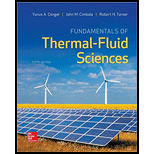
Concept explainers
a)
The change in entropy of helium.
a)
Explanation of Solution
Given:
The volume of the helium gas
The initial pressure of the helium gas
The initial temperature of the helium gas
The final pressure of the helium gas
The initial temperature of the helium gas
The surrounding temperature
Calculation:
Refer Table A-1E, “the molar mass, gas constant and critical–point properties table”,
The gas constant of helium
Calculate the mass of helium
Refer Table A-2E, “Ideal-gas specific heats of various common gases”,
The specific heat at constant pressure
The specific heat at constant volume
Calculate the change in entropy of helium.
Thus, the change in entropy of helium is
b)
The entropy change of the surrounding.
b)
Explanation of Solution
Calculate the final volume of the helium
Write the expression for the polytropic process.
Rewrite the above Equation to obtain the exponent n.
Calculate the boundary work for the polytropic process
Write the expression for the energy balance equation of the system.
Here, net energy transfer inside the system is
Substitute
Calculate the entropy change of the surrounding.
Thus, the entropy change of the surrounding is
c)
Whether this process is reversible, irreversible, or impossible.
c)
Explanation of Solution
Calculate the total entropy change during the process.
Thus, the total entropy change during the process is
The value of the total change in entropy
Want to see more full solutions like this?
Chapter 8 Solutions
Fundamentals of Thermal-Fluid Sciences
 Elements Of ElectromagneticsMechanical EngineeringISBN:9780190698614Author:Sadiku, Matthew N. O.Publisher:Oxford University Press
Elements Of ElectromagneticsMechanical EngineeringISBN:9780190698614Author:Sadiku, Matthew N. O.Publisher:Oxford University Press Mechanics of Materials (10th Edition)Mechanical EngineeringISBN:9780134319650Author:Russell C. HibbelerPublisher:PEARSON
Mechanics of Materials (10th Edition)Mechanical EngineeringISBN:9780134319650Author:Russell C. HibbelerPublisher:PEARSON Thermodynamics: An Engineering ApproachMechanical EngineeringISBN:9781259822674Author:Yunus A. Cengel Dr., Michael A. BolesPublisher:McGraw-Hill Education
Thermodynamics: An Engineering ApproachMechanical EngineeringISBN:9781259822674Author:Yunus A. Cengel Dr., Michael A. BolesPublisher:McGraw-Hill Education Control Systems EngineeringMechanical EngineeringISBN:9781118170519Author:Norman S. NisePublisher:WILEY
Control Systems EngineeringMechanical EngineeringISBN:9781118170519Author:Norman S. NisePublisher:WILEY Mechanics of Materials (MindTap Course List)Mechanical EngineeringISBN:9781337093347Author:Barry J. Goodno, James M. GerePublisher:Cengage Learning
Mechanics of Materials (MindTap Course List)Mechanical EngineeringISBN:9781337093347Author:Barry J. Goodno, James M. GerePublisher:Cengage Learning Engineering Mechanics: StaticsMechanical EngineeringISBN:9781118807330Author:James L. Meriam, L. G. Kraige, J. N. BoltonPublisher:WILEY
Engineering Mechanics: StaticsMechanical EngineeringISBN:9781118807330Author:James L. Meriam, L. G. Kraige, J. N. BoltonPublisher:WILEY





